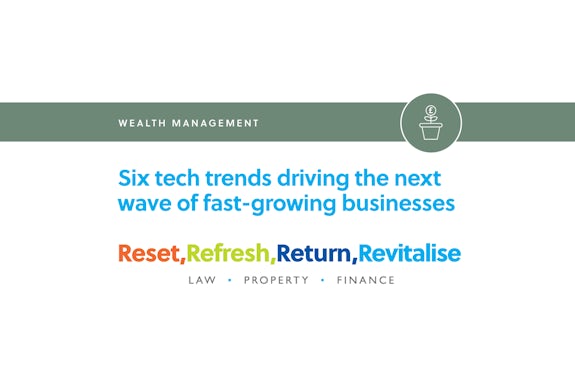
By Andy Gray
May 6, 2025


The COVID-19 pandemic has sped up changes in the way we work, shop, and live. These rapid changes are bolstering underlying trends that will drive the winning companies of tomorrow, says Mark Baribeau, Head of Global Equity at Jennison Associates.
Historically, it’s taken decades for even the most influential technologies to reach mass adoption. But, in recent years, we’ve seen this timeline shorten as consumers embrace new technologies much faster.
For instance, it took 16 years for half the world to own a mobile phone, but only nine years for half the world to own a smartphone.
Having become widespread, smartphones are now dramatically altering the way we communicate, shop, and view content. They’re also driving new technologies, as people spend more time consuming digital media and using mobile internet.
More widely, the faster rate of adoption we’re witnessing today for lots of innovations has exceeded many pre-COVID-19 forecasts. After the crisis, we expect these trends to speed up even further, causing the markets for their products to continue growing at pace.
It’s far too soon to know just how popular these technologies might get once the economy fully recovers. But we believe that the trends below, which were already disruptive before the pandemic and became essential during it, will become revolutionary drivers of growth in the post-pandemic era.
On-demand consumption: Increased mobile internet usage, plus more ways to buy on-demand and customized products, are leading to new delivery formats and business models for just about anything, including shopping, watching, listening, learning and reading. All these online activities have intensified in recent months with so many consumers confined to their homes. For instance, Amazon hired 175,000 employees in March and April this year to help keep up with soaring online orders.
E-commerce: E-commerce (or online shopping) has been growing immensely in size and breadth but has much further to go, representing only 14% of global retail sales in 2019. This year’s lockdowns led to an increase in this trend, attracting once-resistant consumers and demand for categories like groceries, which were previously dominated by brick-and-mortar stores. In the US (one of the world’s largest retail markets) e-commerce penetration spiked 5% in two months – an amount that took the industry six years to reach before the pandemic.
Digital payments: As these trends in online spending take hold, companies that help digital payments to take place will stand to benefit. Take as an example Adyen, a leading Netherlands-based payment processor with that dealt with €240 billion of payments in 2019. Its cloud-based infrastructure provides benefits to both merchants and consumers, allowing it to roll out updates and new services to customers instantly. Its client list includes over 3,500 companies, including heavyweights like Netflix, Microsoft and Facebook.
Cloud technology for businesses: Businesses want their technology infrastructure to be nimble, secure, and state of the art – and the move to cloud-based technology will help enable this. Cloud-based technology (which delivers computing services over the internet) proved essential during lockdowns this year, as millions of employees began working from home. It’s also helped to join up communications between workers, suppliers and customers; it’s allowed companies to secure devices such as smartphones, laptops, and tablets; and it’s driven change in how firms manage their technologies, devices and data sources.
Robotics and autonomy: Ride-hailing apps and self-driving vehicles may one day eliminate the need for people to own or operate their own cars. Similarly, robotics and automated tools, which were already popular among manufacturers, are set to become more widespread thanks to lockdowns and travel restrictions. Many businesses were hurt when their supply chains were disrupted due to these restrictions, so companies are reconsidering bringing outsourced manufacturing back to their home markets. This will be costly, so they will look into boosting productivity through robotic and automated means, providing long-term growth opportunities for companies that provide these technologies.
Health technology: Ageing populations and diseases around the world will continue to require new approaches to health technology and therapies. The healthcare sector is evolving fast, thanks to things like robotic surgeries, liquid biopsies, continuous glucose monitoring, immunotherapies, and customized genetic therapies. And the medical community has also embraced new genetic analysis for a range of uses in recent years. The insights gained from this breadth of research are likely to be applied to treating a host of diseases, with potential to change the face of future treatments for some of the world’s deadliest conditions.
These six trends will continue to gain momentum in the coming years, especially if COVID-19 leads to long-term changes in the ways that we live and work.
Many of these changes were taking place already, but the world’s response to the pandemic means that they’re speeding up quickly. For that reason, these are the areas that we’re focusing on in order to find the next generation of breakout growth stocks.
Mark Baribeau is Head of Global Equity at Jennison Associates. Jennison Associates is a fund manager for St. James’s Place.
The opinions expressed are those of the fund managers listed above and are subject to market or economic changes. This material is not a recommendation, or intended to be relied upon as a forecast, research or advice. The views are not necessarily shared by other investment managers or by St. James’s Place Wealth Management.
The information and opinions contained in this blog are for information only. They are not intended to constitute advice and should not be relied upon or considered as a replacement for advice. Before acting on any of the information contained in this blog, please seek specific advice from Gilson Gray Financial Management.